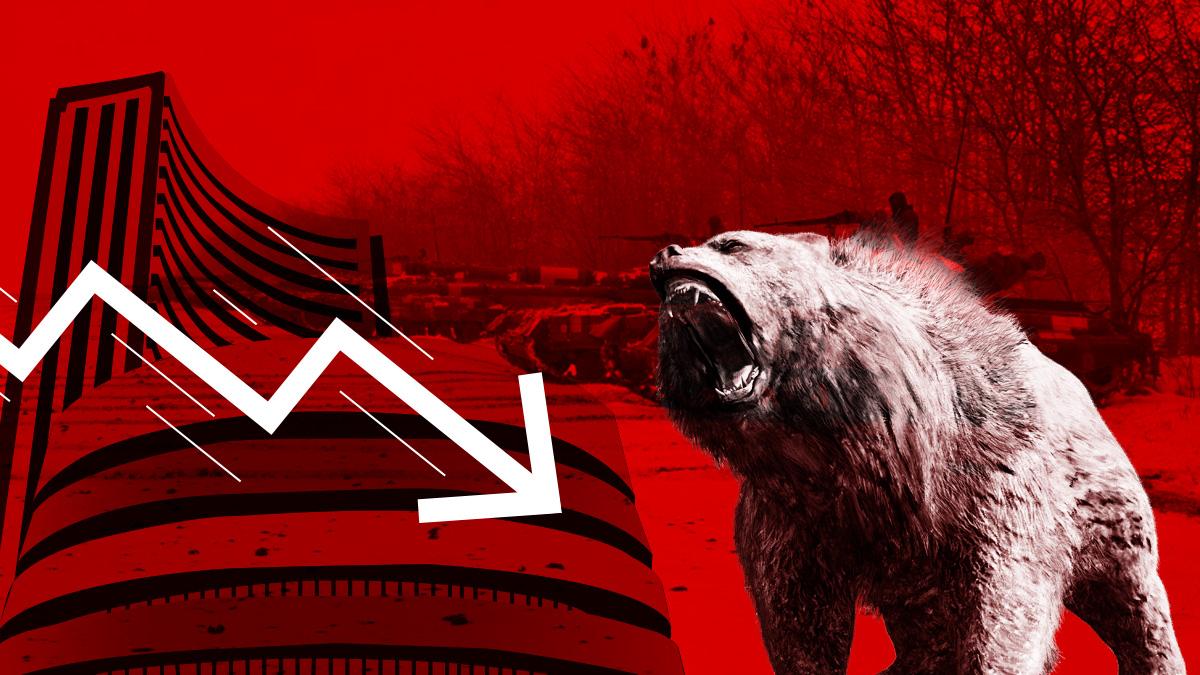Market News
SENSEX, NIFTY tumble 7% from all-time highs touched in September; top factors behind the market crash

7 min read | Updated on October 23, 2024, 20:42 IST
SUMMARY
Selling in the mid- and small-cap stocks has been sharper. On Tuesday, the BSE Midcap index slumped 2.52% to 45,974.31 levels, while the BSE SmallCap index tanked 3.81% to 53,530.92 points.

Data shows that SENSEX, the 30-share index of the BSE, has declined 5,757.53 points, or 6.69%, from its record high of 85,978.25 levels
Similarly, the broader NIFTY50 index of the NSE has crashed 1,842 points, or 7% from its peak of 26,277.35 levels.
A number of individual stocks have faced a lot of hammering. Selling in the mid- and small-cap stocks has been sharper. On Tuesday, the BSE Midcap index slumped 2.52% to 45,974.31 levels, while the BSE SmallCap index tanked 3.81% to 53,530.92 points.
A host of factors are behind this steep fall in the market, ranging from overstretched valuations, geopolitical tensions, volatility in oil prices, elevated commodity prices, disappointing Q2 earnings, jitters ahead of the US presidential election, China stimulus measures, and the exodus of foreign investors.
Wipro's Q2 numbers were decent, but its weak guidance for Q3 negated the positives. Wipro's revenue growth guidance (CC) for Q3 FY25 is -2% to 0%. This is a slight downgrade from the previous quarter's guidance of -1% to +1%, note analysts.
“We saw the cautious trends of the last few quarters continue to play out in this quarter as well. Amidst an uncertain geopolitical situation, our biggest vertical, BFSI, showed signs of recovery," said K Krithivasan, Chief Executive Officer and Managing Director.
TCS added its discretionary spending was impacted. Its operating margin for the quarter was 24.1%, a decline of 0.2% YoY.
Banking names, too, worried Street. For instance, RBL Bank reported a 24% decline in net profit in the September quarter to ₹223 crore on asset quality challenges emanating from credit cards and microlending books.
Kotak Mahindra Bank's net NPAs, or bad loans, rose to 0.43% in Q2 FY25 from 0.37% in Q2 FY24.
The management said that in the first 15 days of the festive season, it has seen a growth in the range of 1-2% as compared to Bajaj Auto's expectation of 5-6% and brokerages' expectation of 8-10%. Its gross margin contracted 130 basis points sequentially on a higher share of lower-margin electric two-wheelers.
Further, Suresh Narayanan, Chairman and Managing Director of Nestlé India, flagged muted consumer demand with high commodity prices.
In the statement, the MD said, “Despite a challenging external environment with muted consumer demand and high commodity prices, especially for coffee and cocoa, we remained resilient in our pursuit to deliver growth."
The chairman added, "This quarter some key brands witnessed pressure due to softer consumer demand, and we focus on them and have in place robust action plans."
Another big name in the consumption space, Avenue Supermarts, too, disappointed the Street with its Q2 results. The company noted that the increased operating expenses aimed at improving service levels have compressed the EBITDA margin.
Additionally, growth in DMart Ready (an online ordering platform) slowed to 22% Y-o-Y in H1FY25, down from 32% in FY24. The management also acknowledged that online grocery competitors are affecting its high-performing metro stores.
This quarter marked the lowest revenue growth ever recorded for the company at just 14% year-on-year. The like-for-like (LFL) growth was only 5.5%, a notable drop from the previous high single digits.
Dabur, yet another prominent name in the consumption space in its Q2 business update, said its profitability in the second quarter will be impacted due to low primary sales with heavy rain and floods in parts of India affecting out-of-home consumption and consumer offtake despite demand trends seeing some improvement.
In a move to boost the property market, the local government of Guangzhou last week fully relaxed purchase restrictions for large homes, removing the cap on the number of apartments that could be purchased imposed last year.
This has resulted in investors' revived stance on China, sadly at the expense of India.
After announcing the most aggressive monetary support measures since the pandemic, China further pledged to significantly increase debt to revive its sputtering economy. “Growth expectations for China sprung back to life following the policy pivot,” BofA Securities wrote in its recent report.
Recently, Christopher Wood, the global head of equity strategy at Jefferies, trimmed his exposure to Indian equities by one percentage point in the Asia Pacific ex-Japan relative-return portfolio and increased the weight of China by two percentage points.
So far this month, foreign investors have sold a net ₹86,458.34 crore in equities, surpassing the COVID-19-induced sell-off of March 2020, when ₹61,972.75 crore was offloaded. This makes October a historic month for heavy selling pressure by FPIs, as per a report by ANI.
"India represents elevated market levels with historically high valuations, which seem overexuberant given the slowing economy, persistent inflation, high taxes, and high interest rates. On top of this unfavorable macroeconomic environment, we have seen underwhelming earnings announcements across sectors. This has contributed to the continued FII outflows from Indian markets," said Ajay Bagga, an independent market analyst.
India is heavily dependent on oil imports. According to a commentary by the National Bureau of Asian Research, India finds it necessary to import almost 85% of the oil it requires to satisfy the appetite of an expanding economy, including a substantial refining and re-export business.
The immediate outcome of the oil price rise is the augmented cost of production due to improved fuel costs. Whenever there is an overall inflation in the economy, the cost of construction would also rise, causing a decrease in supply. On the other hand, inflation implies a decline in the purchasing power of people.
About The Author
Next Story

